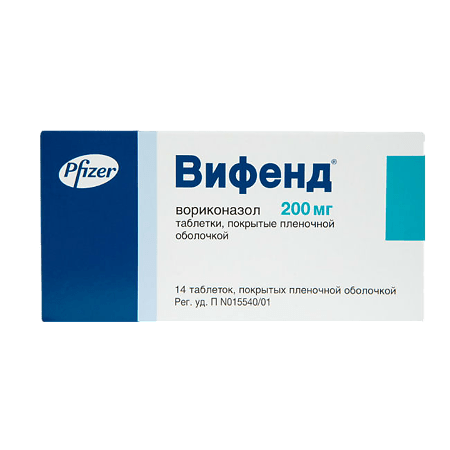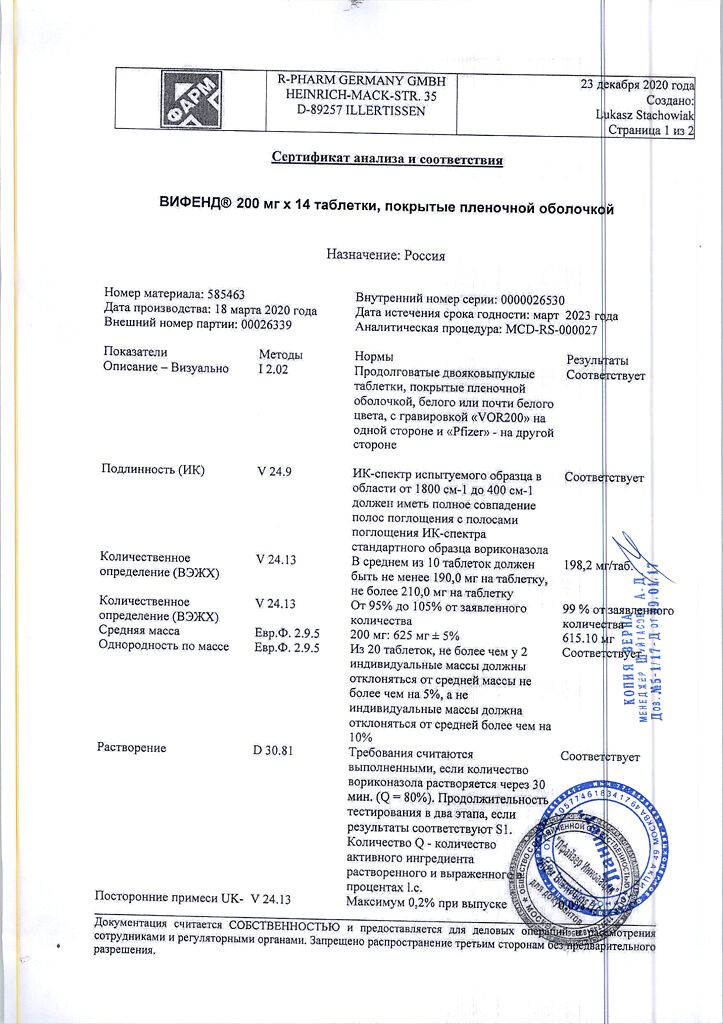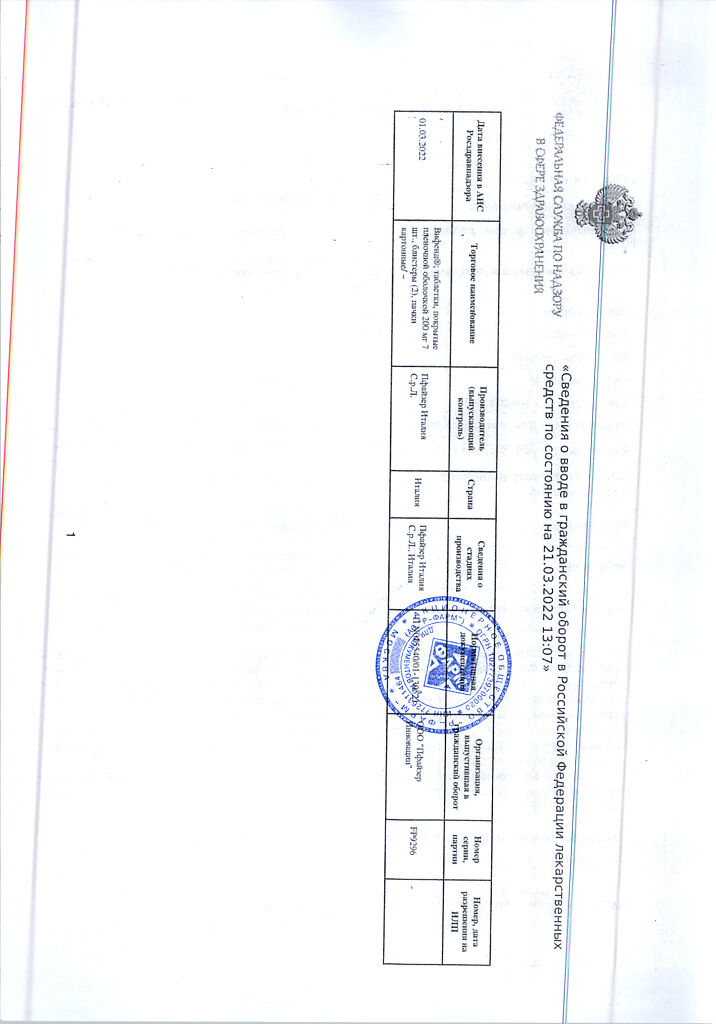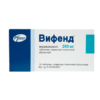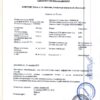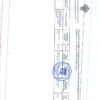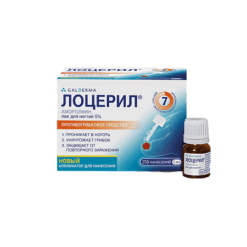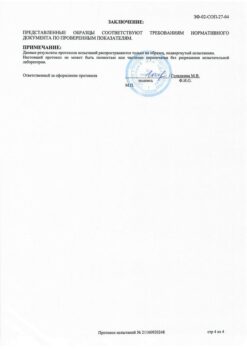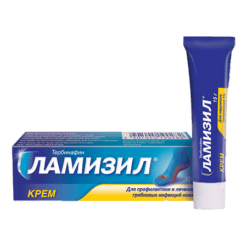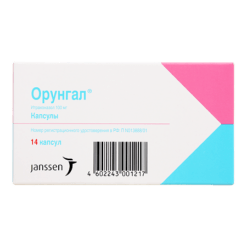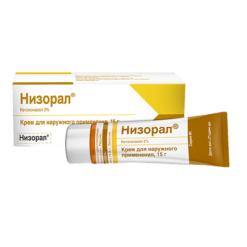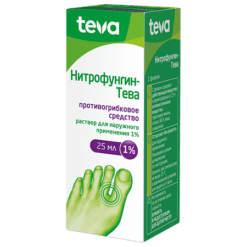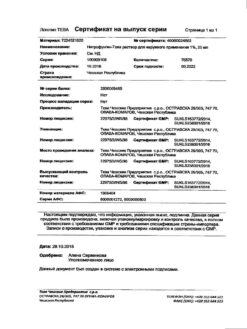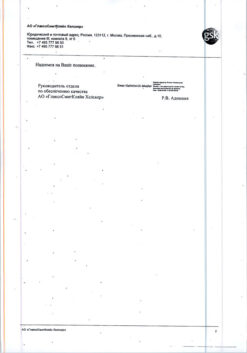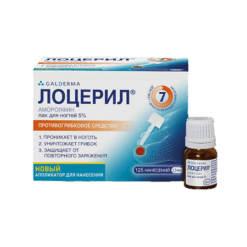No products in the cart.
Vifend, 200 mg 14 pcs
€300.33 €260.28
Description
Voriconazole is a broad-spectrum antifungal drug that belongs to the group of triazole antibiotics.
The mechanism of action of voriconazole is associated with inhibition of 14α-sterol demethylation mediated by fungal cytochrome P450; this reaction is a key step in ergosterol biosynthesis.
In vitro voriconazole has a broad spectrum of antifungal activity and is active against Candida spp. (including fluconazole-resistant strains of C. krusei and resistant strains of C. glabrata and C. albicans), and has a fungicidal effect against all Aspergillus sp. strains studied as well as pathogenic fungi of recent relevance, including Scedosporium or Fusarium, which have limited sensitivity to existing antifungal agents.
The clinical efficacy has been demonstrated in infections caused by Aspergillus spp. including A. flavus, A. fumigatus, A. terreus, A. niger, A. nidulans, Candida spp. including C. albicans, C. dubliniensis, C. glabrata, C. inconspicua, C. krusei, C. parapsilosis, C. tropicalis and C. guilliermondii, Scedosporium spp. including S. apiospermum, S. prolificans and Fusarium spp.
Other fungal infections for which the drug was used (often with partial or complete response) included isolated infections caused by Alternaria spp., Blastomyces dermatitidis, Blastoschizomyces capitatus, Cladosporium spp, Coccidioides immitis, Conidiobolus coronatus, Cryptococcus neoformans, Exserohilum rostratum, Exophiala spinifera, Fonsecaea pedrosoi, Madurella mycetomatis, Paecilomyces lilacinus, Penicillium spp. including P. marneffei, Phialophora richardsiae, Scopulariopsis brevicaulis and Trichosporon spp. including T. beigelii.
In vitro activity of voriconazole against clinical strains Acremonium spp., Alternaria spp., Bipolaris spp., Cladophialophora spp., Histoplasma capsulatum was demonstrated. The growth of most strains was suppressed at voriconazole concentrations from 0.05 to 2 µg/ml.
In vitro activity of voriconazole against Curvularia spp. and Sporothrix spp. was detected, but its clinical significance is unknown.
Pharmacokinetics
Pharmacokinetics of voriconazole were studied in healthy subjects, special groups and patients.
The pharmacokinetics of voriconazole are nonlinear due to saturation of its metabolism. A disproportionate (more pronounced) increase in AUC (area under the curve “concentration-time”) is observed with increasing dose. It has been calculated that increasing the oral dose from 200 mg 2 times a day to 300 mg 2 times a day leads to an average 2.5-fold increase in AUCτ. With intravenous or oral shock doses, plasma concentrations approach equilibrium within the first 24 hours. If a patient does not receive a shock dose, repeated administration of voriconazole 2 times daily causes cumulation of the drug, and equilibrium plasma concentrations are reached by day 6 in most patients.
Voriconazole is rapidly and almost completely absorbed after oral administration; maximum plasma concentrations (Cmax) are reached 1-2 hours after administration. Bioavailability of voriconazole when taken orally is 96%. When voriconazole is repeatedly taken with a fatty food Cmax and AUCτ are decreased by 34% and 24% respectively.
The absorption of voriconazole is independent of the pH of gastric juice.
The calculated volume of distribution of voriconazole in equilibrium is 4.6 l/kg, indicating active distribution of the drug in the tissue. Binding to plasma proteins is 58%.
Voriconazole is determined in the cerebrospinal fluid.
The pharmacokinetics of voriconazole is characterized by high interindividual variability.
In vitro studies showed that voriconazole is metabolized under the action of hepatic cytochrome P450 isoenzymes – CYP2C19, CYP2C9 and CYP3A4.
In vivo studies also suggest that CYP2C19 plays an important role in the metabolism of voriconazole. This enzyme exhibits genetic polymorphism. For example, reduced metabolism of voriconazole can be expected in 15-20% of Asians and 3-5% of whites and blacks. Studies in white and Japanese patients have shown that the AUCτ of voriconazole is, on average, 4 times higher in patients with low metabolism than in homozygous patients with high metabolism. In heterozygous patients with active metabolism, the AUCτ of voriconazole was, on average, 2 times higher than in homozygous patients.
The main metabolite of voriconazole is N-oxide, which accounts for 72% of the circulating labeled metabolites in plasma. This metabolite has minimal antifungal activity and does not contribute to the effect of voriconazole.
Less than 2% of the drug dose is excreted unchanged in the urine.
After repeated intravenous and oral administration of labeled voriconazole, approximately 80% and 83% of the radioactive dose, respectively, are detected in the urine. Most (>94%) of the total dose is excreted within the first 96 h after oral and intravenous administration.
The terminal elimination half-life of voriconazole is dose-dependent and is approximately 6 h when administered orally at a dose of 200 mg. Due to the nonlinearity of pharmacokinetics, the terminal elimination half-life does not predict the cumulation or excretion of voriconazole.
Pharmacokinetics in special groups
Gender
When administered orally repeatedly, Cmax and AUCτ were 83% and 113% higher, respectively, in healthy young women than in young healthy men (18-45 years). There were no significant differences in Cmax and AUCτ in healthy older men and healthy older women (>65 years).
There is no need for dose adjustment depending on sex. Plasma concentrations in men and women are similar.
Age
On repeated oral administration, Cmax and AUCτ in healthy elderly men (>65 years) are 61%) and 86%o higher, respectively, than in healthy young men (18-45 years). There are no significant differences in Cmax and AUCτ in healthy elderly women (>65 years old) and healthy young women (18-45 years old). Safety of voriconazole in young and elderly patients is the same, in connection with that the dose adjustment in elderly age is not required.
Renal dysfunction
. A single oral dose of 200 mg of voriconazole in patients with normal renal function and patients with mild (creatinine clearance 41-60 ml/min) to severe (creatinine clearance In patients with moderate to severe renal function impairment (serum creatinine levels >220 μmol/l, or 2.5 mg/dL), there is a cumulation of the excipient in SBECD lyophilisate for preparation of solution for injection.
Hepatic impairment
After a single oral dose (200 mg), the AUC of voriconazole in patients with mild to moderately severe cirrhosis (Child-Pugh A and B) is 233% higher than in patients with normal liver function. Impaired liver function does not affect the binding of voriconazole to plasma proteins.
Indications
Indications
invasive aspergillosis
severe invasive forms of candidal infections (including C. krusei), resistant to fluconazole.
esophageal candidiasis caused by C. albicans in patients with immunodeficiency.
severe fungal infections caused by Scedosporium spp and Fusarium spp.
severe fungal infections with intolerance or refractoriness to other drugs.
Prevention of “breakthrough” fungal infections in febrile patients at high risk (allogeneic bone marrow recipients, patients with relapsed leukemia).
Pharmacological effect
Pharmacological effect
Voriconazole is a broad-spectrum antifungal drug that belongs to the group of antibiotics with a triazole structure.
The mechanism of action of voriconazole is associated with inhibition of 14α-sterol demethylation mediated by fungal cytochrome P450; this reaction is a key step in the biosynthesis of ergosterol.
In vitro, voriconazole has a broad spectrum of antifungal activity and is active against Candida spp. (including strains of C. krusei resistant to fluconazole, and resistant strains of C. glabrata and C. albicans), and has a fungicidal effect against all studied strains of Aspergillus sp. as well as pathogenic fungi that have become relevant recently, including Scedosporium or Fusarium, which have limited sensitivity to existing antifungal agents.
Clinical efficacy has been demonstrated in infections caused by Aspergillus spp., including A. flavus, A. fumigatus, A. terreus, A. niger, A. nidulans, Candida spp., including C. albicans, C. dubliniensis, C. glabrata, C. inconspicua, C. krusei, C. parapsilosis, C. tropicalis and C. guilliermondii, Scedosporium spp., including S. apiospermum, S. prolificans and Fusarium spp.
Other fungal infections for which the drug has been used (often with partial or complete response) have included isolated cases of infections caused by Alternaria spp., Blastomyces dermatitidis, Blastoschizomyces capitatus, Cladosporium spp., Coccidioides immitis, Conidiobolus coronatus, Cryptococcus neoformans, Exserohilum rostratum, Exophiala spinifera, Fonsecaea pedrosoi, Madurella mycetomatis, Paecilomyces lilacinus, Penicillium spp., including P. marneffei, Phialophora richardsiae, Scopulariopsis brevicaulis and Trichosporon spp., including T. beigelii.
In vitro activity of voriconazole has been demonstrated against clinical strains of Acremonium spp., Alternaria spp., Bipolaris spp., Cladophialophora spp., Histoplasma capsulatum. The growth of most strains was inhibited at voriconazole concentrations ranging from 0.05 to 2 μg/ml.
In vitro activity of voriconazole against Curvularia spp. and Sporothrix spp., but its clinical significance is unknown.
Pharmacokinetics
The pharmacokinetics of voriconazole were studied in healthy people, representatives of special groups and patients.
The pharmacokinetics of voriconazole is nonlinear due to the saturation of its metabolism. As the dose increases, a disproportionate (more pronounced) increase in AUC (area under the concentration-time curve) is observed. It is estimated that increasing the oral dose from 200 mg twice daily to 300 mg twice daily results in an average 2.5-fold increase in AUCτ. With intravenous or oral administration of loading doses, plasma concentrations approach equilibrium within the first 24 hours. If the patient does not receive a loading dose, then with repeated use of voriconazole 2 times a day, the drug cumulates, and equilibrium plasma concentrations are achieved by the 6th day in most patients.
Voriconazole is rapidly and almost completely absorbed after oral administration; Maximum plasma concentrations (Cmax) are achieved 1-2 hours after administration. The bioavailability of voriconazole when taken orally is 96%. When voriconazole is repeated with a fatty meal, Cmax and AUCτ are reduced by 34% and 24%, respectively.
The absorption of voriconazole is independent of gastric pH.
The estimated volume of distribution of voriconazole at steady state is 4.6 L/kg, indicating active distribution of the drug into tissue. Plasma protein binding is 58%.
Voriconazole is detected in the cerebrospinal fluid.
The pharmacokinetics of voriconazole is characterized by high interindividual variability.
In vitro studies have shown that voriconazole is metabolized by the hepatic isoenzymes of cytochrome P450 – CYP2C19, CYP2C9 and CYP3A4.
In vivo studies also suggest that CYP2C19 plays an important role in the metabolism of voriconazole. This enzyme exhibits genetic polymorphism. For example, decreased metabolism of voriconazole can be expected in 15-20% of Asians and 3-5% of whites and blacks. Studies in Caucasians and Japanese subjects have shown that in poor metabolizers, the voriconazole AUCτ is on average 4 times higher than in homozygous high metabolizers. In heterozygous patients with active metabolism, the AUCτ of voriconazole is on average 2 times higher than in homozygous patients.
The main metabolite of voriconazole is N-oxide, which accounts for 72% of circulating labeled metabolites in plasma. This metabolite has minimal antifungal activity and does not contribute to the effect of voriconazole.
Less than 2% of the drug dose is excreted unchanged in the urine.
After repeated intravenous and oral administration of labeled voriconazole, approximately 80% and 83% of the radioactive dose, respectively, are found in the urine. The majority (>94%) of the total dose is eliminated within the first 96 hours after oral and intravenous administration.
The terminal half-life of voriconazole is dose dependent and is approximately 6 hours when the drug is taken orally at a dose of 200 mg. Due to the non-linearity of pharmacokinetics, the terminal half-life does not predict the accumulation or elimination of voriconazole.
Pharmacokinetics in special groups
Gender
With repeated oral administration, Cmax and AUCτ in healthy young women were 83% and 113% higher, respectively, than in young healthy men (18-45 years). There are no significant differences in Cmax and AUCτ between healthy elderly men and healthy elderly women (>65 years).
There is no need for dose adjustment depending on gender. Plasma concentrations are similar in men and women.
Age
With repeated oral administration, Cmax and AUCτ in healthy elderly men (>65 years) are 61%) and 86% higher, respectively, than in healthy young men (18-45 years). There are no significant differences in Cmax and AUCτ in healthy elderly women (>65 years) and healthy young women (18-45 years). The safety of voriconazole is similar in young and elderly patients, and therefore no dosage adjustment is required in the elderly.
The mean steady-state plasma concentrations of the drug in children receiving the drug at a dose of 4 mg/kg every 12 hours are comparable to those in adults receiving voriconazole at a dose of 3 mg/kg every 12 hours. The mean concentration was 1186 ng/ml in children and 1155 ng/ml in adults. In this regard, the recommended maintenance dose in children aged 2 to
Renal dysfunction
With a single oral dose of 200 mg voriconazole in patients with normal renal function and patients with mild (creatinine clearance 41-60 ml/min) to severe (creatinine clearance in patients with moderate or severe renal impairment (serum creatinine levels > 220 µmol/l, or 2.5 mg/dl) there is an accumulation of the excipient included in in the composition of the lyophilisate for the preparation of solution for injection – SBECD.
Liver dysfunction
After a single oral dose (200 mg), the AUC of voriconazole in patients with mild to moderately severe liver cirrhosis (Child-Pugh A and B) is 233% higher than in patients with normal liver function. Impaired liver function does not affect the binding of voriconazole to plasma proteins.
With repeated oral administration, the AUCX of voriconazole is comparable in patients with moderate liver cirrhosis (Child-Pugh B) receiving the drug at a maintenance dose of 100 mg twice daily and in patients with normal liver function receiving voriconazole at a dose of 200 mg twice daily. There is no information on pharmacokinetics in patients with severe liver cirrhosis (Child-Pugh C).
Special instructions
Special instructions
Sampling for culture and other laboratory tests (serology, histopathology) for the purpose of isolating and identifying pathogens should be done before treatment. Therapy may be initiated pending culture and other laboratory results, but if available, treatment should be adjusted accordingly.
Clinical strains with reduced sensitivity to voriconazole have been isolated.
However, elevated minimal inhibitory concentrations (MICs) do not always predict clinical failure; There are cases where voriconazole was effective in patients infected with microorganisms resistant to other azoles. Assessing the correlation between in vitro activity and clinical treatment outcomes is difficult given the complexity of the patients included in clinical studies; Breakpoint concentrations for voriconazole to assess sensitivity to this drug have not been established.
Hypersensitivity: Patients with hypersensitivity to other azoles should use voriconazole with caution.
Cardiovascular Adverse Events: The use of voriconazole is associated with prolongation of the QT interval on the electrocardiogram, which is accompanied by rare cases of ventricular fibrillation-flutter in patients receiving voriconazole therapy (in critically ill patients with multiple risk factors such as cardiotoxic chemotherapy, cardiomyopathy, hypokalemia and concomitant therapy, which could contribute to the development of this complication). Voriconazole should be administered with caution to patients with these potentially proarrhythmic conditions (see Dosage and Administration).
Hepatotoxicity: Infrequent (0.1-1%) cases of serious liver reactions (including clinically manifested hepatitis, cholestasis and hepatic cell failure, including death) have been observed during treatment with voriconazole. Adverse events from the liver are mainly observed in patients with serious diseases (mainly malignant blood tumors). In patients without any risk factors, transient liver reactions, including hepatitis and jaundice, are observed. Liver dysfunction is usually reversible and disappears after cessation of treatment.
Monitoring liver function: During treatment with voriconazole, it is recommended to regularly monitor liver function, especially liver function tests and bilirubin. If clinical signs of liver disease that may be associated with voriconazole occur, the advisability of discontinuing therapy should be discussed.
Adverse events from the kidneys: Cases of acute renal failure have been observed in severely ill patients receiving voriconazole.
Renal function monitoring:
Patients should be monitored for signs of renal dysfunction. To do this, it is necessary to conduct laboratory tests, in particular, determine the serum creatinine level.
Infusion reactions: When voriconazole is administered intravenously, infusion reactions are observed, mainly “flushing” and nausea. If these symptoms are severe, the advisability of stopping treatment should be discussed (see section Side effects).
Skin reactions: In rare cases, patients treated with voriconazole have developed exfoliative skin reactions such as Stevens-Johnson syndrome. Patients should be observed if a rash appears. If skin lesions progress, it is advisable to discontinue voriconazole.
In addition, the use of voriconazole was accompanied by photosensitivity skin reactions, especially with long-term treatment. During treatment, patients are advised to avoid intense or prolonged exposure to direct sunlight.
Cyclosporine and tacrolimus (CYP3A4 substrates): Patients receiving cyclosporine or tacrolimus may experience clinically significant interactions with voriconazole (see Section Interactions with other drugs and other forms of interaction).
Phenytoin (CYP2C9 substrate and strong CYP450 inducer): Close monitoring of phenytoin levels is recommended when phenytoin is used concomitantly with voriconazole. If possible, the simultaneous use of voriconazole and phenytoin should be avoided unless the expected benefit outweighs the possible risk (see Interactions with other drugs and other forms of interaction).
Rifabutin (CYP450 inducer): When coadministering rifabutin with voriconazole, it is recommended to perform a complete blood count and monitor for adverse effects of rifabutin (e.g., uveitis). Concomitant use of voriconazole and rifabutin should be avoided unless the expected benefit outweighs the possible risk (see Interactions with other drugs and other forms of interaction).
Women of reproductive age
Women of reproductive age should always use effective methods of contraception during treatment.
Impact on the ability to drive a car and use equipment
Voriconazole may cause transient and reversible visual disturbances, including blurred vision, blurred/increased visual perception and/or photophobia. If these symptoms occur, patients should avoid performing potentially dangerous activities such as driving or using complex machinery. While taking voriconazole, patients should not drive at night.
Active ingredient
Active ingredient
Voriconazole
Composition
Composition
1 film-coated tablet contains:
active ingredient:
voriconazole 200 mg,
excipients:
lactose monohydrate;
pregelatinized starch;
croscarmellose sodium;
povidone;
magnesium stearate
shell:
Opadry white (hypromellose; titanium dioxide; lactose monohydrate; glycerol triacetate)
Pregnancy
Pregnancy
There is no adequate information on the use of voriconazole in pregnant women.
Animal studies have shown that the drug in high doses has a toxic effect on reproductive function. The possible risk to humans is unknown.
Voriconazole should not be used in pregnant women unless the expected benefit to the mother clearly outweighs the possible risk to the fetus.
The excretion of voriconazole into breast milk has not been studied. Voriconazole should not be used in women who are breastfeeding unless the expected benefit clearly outweighs the risk.
Contraindications
Contraindications
Vfend is contraindicated in patients with hypersensitivity to voriconazole or any component of the drug;
simultaneous use of Vfend and CYP3A4 substrates – terfenadine, astemizole, cisapride, pimozide or quinidine is contraindicated, because an increase in plasma concentrations of the latter can lead to a prolongation of the QT interval and, in rare cases, to the development of ventricular flutter/fibrillation;
simultaneous use of Vfend and sirolimus is contraindicated, because voriconazole significantly increased sirolimus plasma concentrations in healthy subjects;
simultaneous use of Vfend with rifampicin, carbamazepine and long-acting barbiturates (for example phenobarbital) is contraindicated, because these drugs significantly reduce the concentration of voriconazole in plasma (see section “Interaction”);
simultaneous use of Vfend with ritonavir (400 mg every 12 hours) is contraindicated, because the latter significantly reduces the concentration of voriconazole in the plasma of healthy people;
simultaneous use of Vfend with efavirenz is contraindicated, because the latter significantly reduces the plasma concentration of voriconazole, and voriconazole, in turn, increases the plasma concentration of efavirenz;
simultaneous use of ergot alkaloids (ergotamine, dihydroergotamine), which are substrates of CYP3A4, is contraindicated, because An increase in the concentration of these substances in plasma can lead to ergotism.
With caution – severe liver failure, severe renal failure (with parenteral administration). Safety and effectiveness in children under 2 years of age have not been established. Hypersensitivity to other drugs – azole derivatives.
Side Effects
Side Effects
The table lists adverse events that were observed with the use of the drug and may have been related to treatment. The most common adverse reactions are visual disturbances, fever, rash, vomiting, nausea, diarrhea, headache, peripheral edema and abdominal pain. Adverse reactions were usually mild or moderate. No clinically significant dependence of drug safety on age, race or gender has been identified
Body system
Frequency*Adverse drug reactions GeneralVery commonFever, peripheral edemaFrequentChills, asthenia, chest pain, reactions/inflammation at the injection site, influenza-like syndromeCardiovascularFrequentDecreased blood pressure, thrombophlebitis, phlebitisRareAtrial arrhythmias, bradycardia, tachycardia, ventricular arrhythmia.Very rareSupraventricular tachycardia, complete atrioventricular block, bundle branch block, nodal arrhythmias, ventricular tachycardia (including ventricular flutter), QT prolongation, ventricular fibrillation.DigestionVery commonNausea, vomiting, diarrhea, abdominal painFrequentIncreased liver function tests (including AST, AJIT, alkaline phosphatase, gamma-GT, LDH, bilirubin), jaundice, cheilitis, cholestasis. RareCholecystitis, cholelithiasis, constipation, duodenitis, dyspepsia, liver enlargement, gingivitis, glossitis, hepatitis, liver failure, pancreatitis, swelling of the tongue, peritonitisVery rarePseudomembranous colitis, hepatic comaEndocrineRareAdrenal insufficiencyVery rareHyperthyroidism, hypothyroidismImmuneRareAllergic reactions, anaphylactoid reactionsBlood and lymphatic FrequentThrombocytopenia, anemia (including macrocytic, microcytic, normocytic, megaloblastic, aplastic), leukopenia, pancytopeniaRareLymphadenopathy, agranulocytosis, eosinophilia, disseminated intravascular coagulation syndrome, suppression of bone marrow hematopoiesisVery rareLymphangitisMetabolism and nutritionFrequentHypokalemia, hypoglycemiaRareHypercholesterolemiaMusculoskeletalFrequentPain in backRareArthritisNervousVery commonHeadacheFrequentDizziness, hallucinations, confusion, depression, anxiety, tremor, agitation, paresthesiaRareAtaxia, cerebral edema, hypertension, hypoesthesia, nystagmus, dizziness, syncopeVery rareGuienne-Barre syndrome, oculomotor crisis, extrapyramidal syndrome Respiratory Frequent Respiratory distress syndrome, pulmonary edema, sinusitis Skin and subcutaneous tissues Very common Rash Frequent Pruritus, maculopapular rash, photosensitivity skin reactions, alopecia, exfoliative dermatitis, facial edema, purpura Rare Toxic epidermal necrolysis, eczema, psoriasis, Stevens-Johnson syndrome, urticaria Very rareAngioedema, discoid lupus erythematosus, erythema multiforme, toxic epidermal necrolysisSensory organsVery commonVisual disturbances (including impaired/increased visual perception, blurred vision, changes in color vision, photophobia)RareBlepharitis, optic neuritis, papilledema, scleritis, impaired taste perception, diplopiaVery rare Retinal hemorrhage, corneal opacities, optic atrophy Genitourinary Frequent Increased creatinine, acute renal failure, hematuria Rare Increased residual urea nitrogen, albuminuria, nephritis Very rare Renal tubular necrosis
*Frequency assessment criteria were as follows: very frequent >10%; frequent – from >1% to >0.1% to
Visual impairment
Visual disturbances are common during treatment with voriconazole. Approximately 30% of patients experience visual disturbances: blurred vision, changes in color vision, or photophobia. Visual impairment is transient and completely reversible; in most cases they disappear spontaneously within 60 minutes. With repeated use of voriconazole, a weakening of their severity is observed. Visual disturbances are usually mild, rarely require cessation of treatment and do not lead to any long-term consequences. Visual impairment may be associated with higher plasma concentrations and/or doses of the drug.
The mechanism of their development is not known, although the drug most likely acts on the retina. When studying the effect of voriconazole on retinal function in healthy volunteers, a decrease in the amplitude of waves on the electroretinogram (ERG) was revealed. This method measures the electrical current in the retina. ERG changes did not increase with continued treatment for 29 days and completely disappeared after discontinuation of voriconazole. The effect of longer voriconazole therapy (more than 29 days) on visual function is unknown.
Skin reactions
Skin reactions occur in 19% of patients taking voriconazole. In most cases, the rash is mild or moderate. In rare cases, severe skin reactions have occurred during treatment with voriconazole, including Stevens-Johnson syndrome (uncommon), toxic epidermal necrolysis (rare) and erythema multiforme (rare).
If a rash appears, the patient should be carefully monitored, and if skin changes progress, it is advisable to discontinue voriconazole. Patients receiving long-term therapy with voriconazole may develop photosensitivity skin reactions.
Liver function indicators
The overall incidence of clinically significant increases in transaminase activity in patients receiving voriconazole is 13.4%. Impaired liver function may be associated with higher plasma concentrations and/or doses of the drug. In most cases, abnormalities in liver function tests disappear with continued treatment (without changing the dose or after its adjustment) or its cessation.
Cases of severe hepatotoxicity have rarely been observed with the use of voriconazole in patients with serious underlying diseases. These cases may include cases of jaundice, hepatitis and liver cell failure leading to death.
Infusion-related reactions
During intravenous infusion of voriconazole, anaphylactoid reactions may occur, including flushing, fever, sweating, tachycardia, chest tightness, shortness of breath, fainting, nausea, itching, and rash. These symptoms appear immediately after starting the infusion.
Interaction
Interaction
Effect of other drugs on the pharmacokinetics of voriconazole
Voriconazole is metabolized by the action of cytochrome P450 isoenzymes – CYP2C19, CYP2C9 and CYP3A4. Inhibitors or inducers of these isoenzymes may cause an increase or decrease in voriconazole plasma concentrations, respectively.
Plasma levels of voriconazole are significantly reduced when administered concomitantly with the following drugs:
Rifampin (CYP450 inducer): Rifampin (600 mg once daily) reduces the Cmax (maximum plasma concentration) and AUC of voriconazole by 93% and 96%, respectively.
The simultaneous use of voriconazole and rifampicin is contraindicated (see section Contraindications).
Carbamazepine and long-acting barbiturates (potent CYP450 inducers):
Carbamazepine and long-acting barbiturates (eg, phenobarbital) appear to significantly reduce voriconazole plasma concentrations, although their interaction has not been studied.
Concomitant use of voriconazole with carbamazepine and long-acting barbiturates is contraindicated (see section Contraindications).
Given the slight pharmacokinetic interaction or lack of significant interaction, dosage adjustment of the following drugs is not required:
Cimetidine (non-specific inhibitor of CYP450 and also increases gastric pH): Cimetidine (400 mg 2 times daily) causes an increase in Cmax and AUCX of voriconazole by 18% and 23%, respectively. Voriconazole dose adjustment is not recommended.
Ranitidine (increases gastric pH): Ranitidine (150 mg 2 times daily) does not have a significant effect on the Cmax and AUCτ of voriconazole.
Macrolide antibiotics: Erythromycin (CYP3A4 inhibitor; 1 g 2 times a day) and azithromycin (500 mg once a day) do not have a significant effect on the Cmax and AUCτ of voriconazole.
Effect of voriconazole on other drugs
Voriconazole inhibits the activity of cytochrome P450 isoenzymes – CYP2C19, CYP2C9 and CYP3A4. In this regard, voriconazole may increase plasma concentrations of substances that are metabolized by these CYP450 isoenzymes.
Concomitant use of voriconazole with the following drugs is contraindicated:
Terfenadine, astemizole, cisapride, pimozide and quinidine (CYP3A4 substrates): Although the interaction with these drugs has not been studied, the simultaneous use of voriconazole with terfenadine, astemizole, cisapride, pimozide or quinidine is contraindicated as an increase in their plasma concentrations may lead to prolongation of the QT interval and in rare cases to the development of ventricular fibrillation/flutter.
Sirolimus (CYP3A4 substrate): Voriconazole increases the Cmax and AUCT of sirolimus (2 mg single dose) by 556% and 1014%, respectively. Concomitant use of voriconazole and sirolimus is contraindicated.
Ergot alkaloids (CYP3A4 substrates): Although interactions with these drugs have not been studied, voriconazole may cause increased plasma concentrations of ergot alkaloids (ergotamine and dihydroergotamine) and the development of ergotism. Concomitant use of ergot alkaloids with voriconazole is contraindicated.
Interactions with voriconazole may result in increased blood concentrations of the following drugs: In this regard, their simultaneous use requires constant monitoring and/or dose adjustment.
Cyclosporine (CYP3A4 substrate): In stable renal transplant patients, voriconazole increases the Cmax and AUCτ of cyclosporine by at least 13% and 70%), respectively. When prescribing voriconazole to patients receiving cyclosporine, it is recommended to reduce the dose of cyclosporine by half and monitor its plasma levels. An increase in cyclosporine concentration is accompanied by nephrotoxicity. After discontinuation of voriconazole, cyclosporine levels should be monitored and the dose increased if necessary.
Tacrolimus (CYP3A4 substrate): Voriconazole increases the Cmax and AUCτ (area under the concentration-time curve until the last quantitative measurement) of tacrolimus (0.1 mg/kg single dose) by 117% and 221%, respectively. When prescribing voriconazole to patients receiving tacrolimus, it is recommended to reduce the dose of the latter to one third and monitor its plasma levels. Increased tacrolimus levels are associated with nephrotoxicity. After discontinuation of voriconazole, it is necessary to monitor the concentration of tacrolimus and, if necessary, increase its dose.
Warfarin (CYP2C9 substrate): Concomitant use of voriconazole (300 mg twice daily) with warfarin (30 mg once) was associated with an increase in maximum prothrombin time by up to 93%. When prescribing warfarin and voriconazole simultaneously, it is recommended to monitor prothrombin time.
Other oral anticoagulants, eg phenprocoumon, acenocoumarol (CYP2C9, CYP3A4 substrates): Voriconazole may cause an increase in plasma coumarin concentrations and prothrombin time. If voriconazole is prescribed to patients receiving coumarin drugs, the prothrombin time should be monitored at frequent intervals and the dose of anticoagulants should be adjusted accordingly.
Sulfonylureas (CYP2C9 substrates): Voriconazole may increase plasma concentrations of sulfonylureas (eg, tolbutamide, glipizide and glibenclamide) and cause hypoglycemia. If they are used concomitantly, carefully monitor blood glucose levels.
Statins (CYP3A4 substrates): In vitro, voriconazole inhibits the metabolism of lovastatin (in human liver microsomes). In this regard, voriconazole may cause an increase in plasma concentrations of statins metabolized by CYP3A4. When using them simultaneously, it is recommended to evaluate the feasibility of adjusting the statin dose. Increased levels of statins were sometimes accompanied by the development of rhabdomyolysis.
Benzodiazepines (CYP3A4 substrates): Although the interaction has not been studied in clinical studies, voriconazole inhibits the in vitro metabolism of midazolam (human liver microsomes). In this regard, voriconazole may cause an increase in plasma levels of benzodiazepines, which are metabolized by CYP3A4 (midazolam, triazolam, alprazolam), and the development of prolonged sedation. If these drugs are used concomitantly, it is recommended to discuss the advisability of adjusting the benzodiazepine dose.
Vinca alkaloids (CYP3A4 substrates): Voriconazole may increase plasma levels of vinca alkaloids (eg, vincristine and vinblastine) and cause neurotoxicity.
It is recommended to discuss the advisability of dose adjustment of vinca alkaloids.
With the simultaneous use of voriconazole with the following drugs, no significant pharmacokinetic interaction was detected, so no dose adjustment is required:
Prednisolone (CYP3A4 substrate): Voriconazole increases the Cmax and AUCτ of prednisolone (60 mg single dose) by 11% and 34%, respectively. Dose adjustment is not recommended.
Digoxin (P-glycoprotein-mediated transport): Voriconazole has no significant effect on the Cmax and AUCτ of digoxin (0.25 mg once daily).
Mycophenolic acid (UDP-glucuronyl transferase substrate): Voriconazole has no effect on the Cmax and AUCτ of mycophenolic acid (1 g single dose).
Phenytoin (CYP2C9 substrate and strong CYP450 inducer): Concomitant use of voriconazole and phenytoin should be avoided unless the expected benefit outweighs the potential risk.
Phenytoin (300 mg once daily) reduced the Cmax and AUCτ of voriconazole by 49% and 69%, respectively. Voriconazole (400 mg twice daily, see section 4.2) increased the Cmax and AUCτ of phenytoin (300 mg once daily) by 67% and 81%, respectively. Careful monitoring of phenytoin plasma levels is recommended when phenytoin is used concomitantly with voriconazole.
Phenytoin can be used in conjunction with voriconazole if the maintenance dose of the latter is increased to 5 mg/kg every 12 hours intravenously or from 200 to 400 mg every 12 hours orally (from 100 to 200 mg every 12 hours orally in patients weighing less than 40 kg); see section Method of administration and dosage).
Rifabutin (CYP450 inducer): Rifabutin (300 mg once daily) reduced the Cmax and AUCτ of voriconazole (200 mg twice daily) by 69% and 78%, respectively. With the simultaneous administration of rifabutin, the Cmax and AUCτ of voriconazole at a dose of 350 mg 2 times a day are 96% and 68% of the values when using voriconazole separately at a dose of 200 mg 2 times a day. When using voriconazole at a dose of 400 mg twice daily, Cmax and AUCτ were, respectively, 104% and 87% higher than when using voriconazole monotherapy at a dose of 200 mg twice daily. Voriconazole at a dose of 400 mg 2 times a day increases the Cmax and AUCτ of rifabutin by 195% and 331%, respectively.
If the expected benefits of treatment outweigh the risks, rifabutin can be used concomitantly with voriconazole. In this case, the maintenance dose of voriconazole should be increased to 5 mg/kg every 12 hours intravenously or from 200 to 350 mg every 12 hours orally (from 100 to 200 mg every 12 hours orally in patients weighing less than 40 kg) (see Dosage and Administration). During simultaneous treatment with rifabutin and voriconazole, it is recommended to regularly perform a complete blood count and monitor for undesirable effects of rifabutin (for example, uveitis).
Omeprazole (CYP2C19 inhibitor; CYP2C19 and CYP3A4 substrate): Omeprazole (40 mg once daily) increased the Cmax and AUCτ of voriconazole by 15% and 41%, respectively. Voriconazole dose adjustment is not recommended.
Voriconazole increases the Cmax and AUCτ of omeprazole by 116% and 280%, respectively. When prescribing voriconazole to patients receiving omeprazole, it is recommended to reduce the dose of the latter by half.
Voriconazole may also inhibit the metabolism of other proton pump blockers that are CYP2C19 substrates.
Indinavir (CYP3A4 inhibitor and substrate): Indinavir (800 mg three times daily) does not have a significant effect on the Cmax and AUCτ of voriconazole.
Voriconazole does not significantly affect the Cmax, Cmin and AUCτ of indinavir (800 mg 3 times daily).
Other HIV protease inhibitors (CYP3A4 substrates and inhibitors): In vitro studies indicate that voriconazole may inhibit the metabolism of HIV protease inhibitors (eg, saquinavir, amprenavir and nelfinavir). In vitro studies have also shown that HIV protease inhibitors may inhibit the metabolism of voriconazole. If voriconazole is used concomitantly with HIV protease inhibitors, patients should be monitored for possible toxic effects.
Non-nucleoside reverse transcriptase inhibitors (CYP3A4 substrates, CYP450 inhibitors or inducers): In vitro studies indicate that delaverdine and efavirenz may inhibit the metabolism of voriconazole. Efavirenz and nevirapine may induce the metabolism of voriconazole, although this effect has not been studied. Voriconazole may inhibit the metabolism of non-nucleoside reverse transcriptase inhibitors. When voriconazole is used concomitantly with non-nucleoside reverse transcriptase inhibitors, patients should be monitored for possible toxic effects.
Overdose
Overdose
There is no known antidote for voriconazole. In case of overdose, symptomatic therapy is indicated. Possible gastric lavage.
Voriconazole is removed by hemodialysis with a clearance of 121 ml/min. SBECD (sulfobutyl ether beta-cyclodextrin) is also dialyzable with a clearance of 55 ml/min. In case of overdose, hemodialysis may help eliminate voriconazole and SBECD from the body.
Storage conditions
Storage conditions
At a temperature not exceeding 30 °C
Shelf life
Shelf life
3 years
Manufacturer
Manufacturer
Pfizer Italy S.r.L., Italy
Additional information
| Shelf life | 3 years |
|---|---|
| Conditions of storage | At a temperature not exceeding 30 °C |
| Manufacturer | Pfizer Italy S.r.l., Italy |
| Medication form | pills |
| Brand | Pfizer Italy S.r.l. |
Related products
Buy Vifend, 200 mg 14 pcs with delivery to USA, UK, Europe and over 120 other countries.

